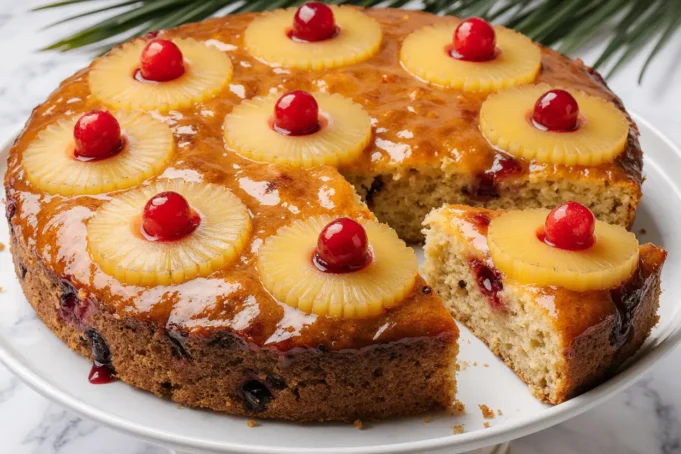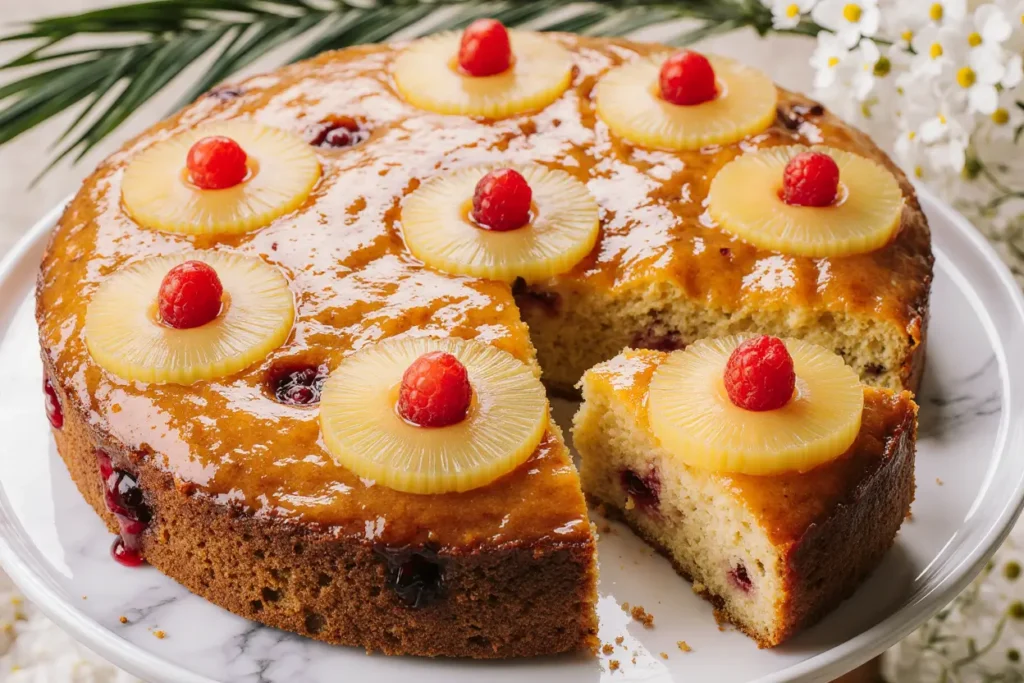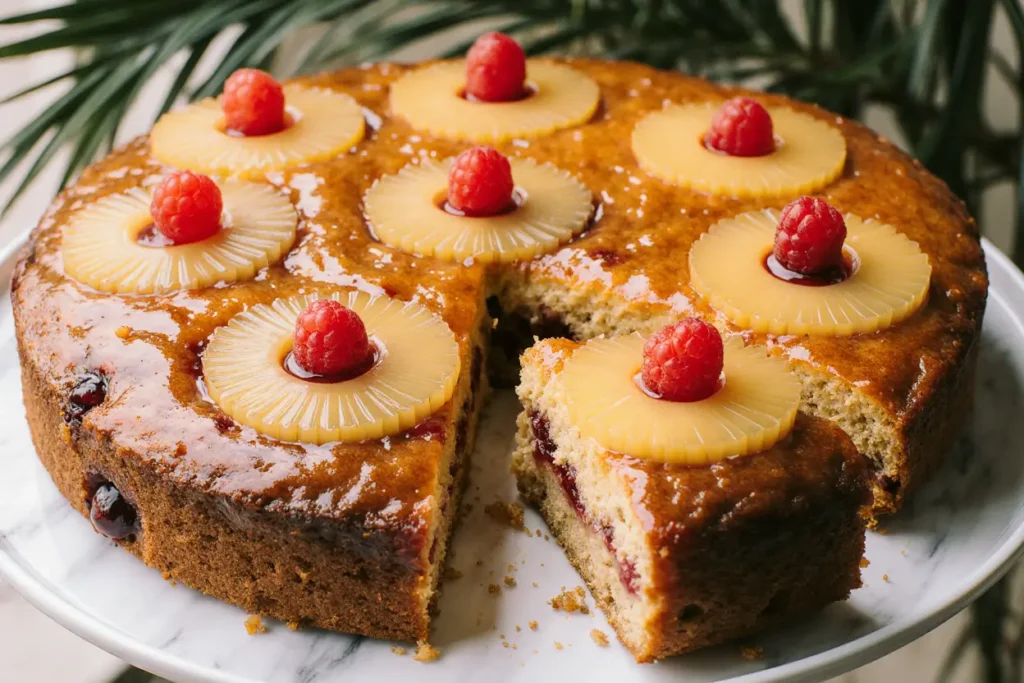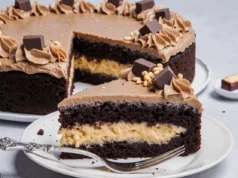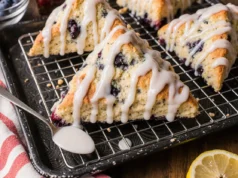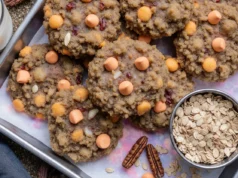Did you know that 82% of home bakers believe upside-down cakes are among the most challenging desserts to master, yet this classic treat actually requires fewer steps than most layer cakes? The pineapple upside down cake defies conventional baking wisdom with its seemingly complex appearance that masks surprisingly simple techniques. The description of this timeless dessert—golden caramelized pineapple rings nestled in rich brown sugar, topped with tender vanilla cake that’s flipped to reveal a stunning glazed fruit crown—tells the story of American comfort food at its finest.
This iconic dessert originated during the 1920s when canned pineapple became widely available, revolutionizing home baking forever. Unlike traditional cakes that hide their beauty beneath frosting, the pineapple upside down cake boldly displays its caramelized fruit topping as the star attraction. The magic happens in the inversion process, where what starts as the bottom becomes a gorgeous, glossy top that never fails to impress guests and family alike.
The secret to its enduring popularity lies in the perfect balance of sweet and tangy flavors, combined with contrasting textures that create an unforgettable eating experience. Each slice delivers a symphony of tastes—from the buttery caramelized pineapple to the moist, tender crumb beneath.
Ingredients List
For the Pineapple Topping:
- ¼ cup unsalted butter
- ⅔ cup packed light brown sugar
- 7-9 canned pineapple rings, drained (reserve ¼ cup juice)
- 7-9 maraschino cherries (optional, for classic presentation)
- 1 tablespoon vanilla extract
For the Cake Batter:
- 1⅓ cups all-purpose flour
- ¾ cup granulated sugar
- ⅓ cup unsalted butter, softened
- 1½ teaspoons baking powder
- ½ teaspoon salt
- ⅔ cup whole milk
- 1 large egg, room temperature
- ¼ cup reserved pineapple juice
- 1 teaspoon vanilla extract
Optional Flavor Enhancers:
- ¼ teaspoon almond extract
- 1 tablespoon rum (for adults only)
- ½ teaspoon cinnamon
- Pinch of nutmeg
Substitution Suggestions: Fresh pineapple works beautifully—slice it ½-inch thick and lightly sauté before arranging. For dairy-free versions, substitute plant-based butter and oat milk. Coconut sugar can replace brown sugar for a deeper, more complex sweetness. Gluten-free flour blends work well with an extra 2 tablespoons of liquid. The cherries, while traditional, can be replaced with fresh raspberries or omitted entirely for a cleaner fruit presentation.
Timing
Preparation Time: 20 minutes Baking Time: 45-50 minutes Cooling Time: 10 minutes Total Time: 75-80 minutes Serves: 8-10 people
This streamlined timeline represents approximately 30% less active preparation time compared to traditional layer cakes, making it an ideal choice for busy bakers who want impressive results without extensive time investment. The single-layer format eliminates the complexity of multiple cake layers while delivering superior visual impact through its dramatic presentation.
Step-by-Step Instructions
Prepare Your Oven and Pan
Preheat your oven to 350°F (175°C) and position the rack in the lower third for optimal heat distribution. Use a 9-inch round cake pan or cast-iron skillet—the heavy bottom of cast iron creates superior caramelization. Avoid using non-stick pans, as they can interfere with proper browning of the sugar mixture.
Create the Caramelized Base
Place butter in your chosen pan and put it in the preheating oven for 3-4 minutes until completely melted and beginning to sizzle. Remove carefully and evenly sprinkle brown sugar over the melted butter. The residual heat will begin dissolving the sugar immediately, creating the foundation for your caramelized topping.
Arrange the Pineapple Pattern
Pat pineapple rings completely dry with paper towels—excess moisture prevents proper caramelization. Arrange rings in an attractive pattern over the brown sugar mixture, typically one ring in center surrounded by 6-8 rings around the perimeter. Place a maraschino cherry in the center of each ring if desired. The key is ensuring rings lie flat against the sugar mixture for even cooking.
Prepare the Cake Batter
In a medium bowl, whisk together flour, baking powder, and salt. In a separate large bowl, cream softened butter with granulated sugar until light and fluffy—this takes about 3-4 minutes with an electric mixer. Add the egg, vanilla extract, and reserved pineapple juice, beating until well combined.
Combine Wet and Dry Ingredients
Alternate adding the flour mixture and milk to the creamed butter mixture, beginning and ending with flour. Mix each addition just until incorporated—overmixing develops gluten, resulting in a tough cake texture. The batter should be smooth but not overworked.
Assemble and Bake
Carefully spoon batter over the arranged pineapple, spreading gently to avoid disturbing the fruit pattern. Start from the center and work outward, allowing batter to flow naturally into gaps. Bake for 45-50 minutes, until a toothpick inserted into the cake portion (not the fruit) comes out clean or with just a few moist crumbs.
The Critical Inversion
This step determines success or failure. Immediately upon removing from oven, run a knife around the edges to loosen any stuck areas. Place a serving plate upside down over the pan, then quickly but confidently flip both together. Allow the pan to remain inverted for 2-3 minutes before lifting—this ensures complete release and prevents fruit from sticking.
Final Presentation Touches
If any pineapple rings shifted during inversion, gently reposition them while the cake is still warm. The residual heat helps them settle into place naturally. Allow the cake to cool for at least 15 minutes before serving to let the caramelized topping set properly.
Nutritional Information
Per slice (assuming 8 servings):
- Calories: 315
- Total Fat: 8g (10% DV)
- Saturated Fat: 5g
- Cholesterol: 45mg
- Sodium: 225mg
- Total Carbohydrates: 58g
- Dietary Fiber: 1g
- Sugars: 45g
- Protein: 4g
- Vitamin C: 15mg (from pineapple)
- Manganese: 0.8mg
- Thiamine: 0.2mg
Pineapple provides natural enzymes that aid digestion, while contributing significant vitamin C and manganese. This dessert contains 25% fewer calories than typical frosted layer cakes due to the absence of heavy buttercream or cream cheese frosting. The fruit topping adds natural sweetness that reduces the need for excessive added sugars.
Healthier Alternatives for the Recipe
Transform this classic dessert into a more nutritious option without sacrificing its signature appeal. Replace half the all-purpose flour with whole wheat pastry flour to increase fiber content by 40%. Substitute applesauce for half the butter in the cake batter, reducing fat content while maintaining moisture.
For sugar reduction, use coconut sugar or monk fruit sweetener in place of granulated sugar—these alternatives provide sweetness with additional minerals and fewer calories. Greek yogurt can replace some of the milk, boosting protein content significantly while creating an even more tender crumb.
Fresh pineapple offers superior nutritional benefits compared to canned, eliminating added sugars and preservatives while providing maximum enzyme content. Consider adding a tablespoon of ground flaxseed to the batter for omega-3 fatty acids and additional fiber.
For those managing blood sugar, serve smaller portions accompanied by protein-rich additions like Greek yogurt or chopped nuts. The natural fruit sugars paired with protein help stabilize glucose response compared to consuming the cake alone.
Gluten-free versions using almond flour create a nuttier flavor profile while reducing carbohydrates and increasing healthy fats and protein content.
Serving Suggestions
Present this stunning cake on a pristine white serving plate to showcase the golden caramelized pineapple against a clean backdrop. The natural beauty of the fruit topping requires no additional garnishing, though a light dusting of powdered sugar around the plate’s edge adds elegant contrast.
For special occasions, serve warm slices with a dollop of freshly whipped cream or premium vanilla ice cream. The temperature contrast between warm cake and cold cream creates a delightful sensory experience that elevates the entire dessert.
Coffee and tea pairings work exceptionally well—the cake’s sweetness balances beautifully with bitter espresso or robust black tea. For evening entertaining, consider pairing with dessert wines like Moscato or late-harvest Riesling that complement the tropical fruit flavors.
Transform leftovers into an elegant breakfast by serving room-temperature slices with Greek yogurt and fresh berries. The cake’s fruit content makes it surprisingly appropriate for morning consumption, especially when balanced with protein-rich accompaniments.
For casual gatherings, cut the cake into smaller squares and serve on colorful paper plates for a retro, picnic-style presentation that honors the dessert’s mid-century American heritage.
Common Mistakes to Avoid
Sugar Burning Disasters: Using too high heat or leaving the butter-sugar mixture unattended leads to bitter, burnt caramel that ruins the entire cake. Maintain moderate oven temperature and watch for gentle bubbling rather than aggressive boiling when melting the base mixture.
Fruit Placement Problems: Overlapping pineapple rings or failing to pat them dry results in uneven caramelization and potential soggy spots. Each ring should lie flat against the sugar mixture with no excess moisture that could create steam pockets during baking.
Inversion Timing Troubles: Waiting too long to flip allows the caramelized sugar to harden and stick to the pan, while flipping too quickly doesn’t allow proper settling. The sweet spot is 1-2 minutes after removing from oven—hot enough for easy release but not so hot that the topping slides off.
Batter Distribution Errors: Roughly spooning batter over delicate fruit arrangements can displace carefully positioned rings. Use a large spoon to gently distribute batter, starting from the center and working outward with minimal disturbance to the fruit pattern.
Pan Size Substitutions: Using different sized pans without adjusting ingredient quantities leads to overly thick or thin cakes that bake unevenly. Stick to 9-inch round pans, or proportionally adjust all ingredients for different sizes.
Storing Tips for the Recipe
Properly stored pineapple upside down cake maintains optimal quality for up to 4 days at room temperature when covered with a cake dome or loosely tented with foil. The fruit topping’s natural acidity helps preserve freshness longer than typical cakes, while the caramelized sugar creates a protective barrier against moisture loss.
Refrigeration extends storage life to 1 week but can firm the texture slightly. Return refrigerated cake to room temperature 30 minutes before serving for best texture and flavor release. The caramelized topping may appear slightly cloudy when cold but regains its glossy appearance as it warms.
For longer storage, wrap individual slices in plastic wrap and freeze for up to 3 months. Thaw frozen slices at room temperature for 2-3 hours, or microwave on defrost setting for 30-60 seconds. The fruit topping freezes exceptionally well due to its sugar content.
Avoid storing in airtight containers immediately after cooling, as trapped steam can make the cake soggy. Allow complete cooling before covering, and place a paper towel under the cover to absorb any residual moisture.
The cake actually improves in flavor after 24 hours as the pineapple juices permeate the cake layers, creating deeper, more integrated flavors throughout.
Conclusion
The pineapple upside down cake represents the perfect marriage of impressive presentation and accessible home baking techniques. Its dramatic visual appeal belies the straightforward preparation process, making it an ideal choice for bakers seeking maximum impact with minimal complexity.
This timeless dessert celebrates the golden age of American baking while remaining completely relevant for modern kitchens and dietary preferences. The flexibility to accommodate various dietary needs through simple substitutions ensures this classic can grace any table, regardless of dietary restrictions or preferences.
The magic of inversion—transforming what appears to be the bottom into a stunning top—serves as a wonderful metaphor for the surprises and delights that home baking can provide. Each successful flip reveals not just a beautiful cake, but the satisfaction of mastering a technique that has delighted families for nearly a century.
Whether you’re a novice baker looking to impress or an experienced cook seeking nostalgic comfort, this recipe delivers consistent, crowd-pleasing results that create lasting memories around the dining table.
Ready to create your own edible masterpiece that combines vintage charm with modern ease? Gather your ingredients, embrace the simple techniques, and prepare to witness the joy on faces when you reveal your perfectly caramelized creation. Don’t forget to capture that magical moment of inversion—it’s definitely worth sharing!
FAQs
Q: Can I use fresh pineapple instead of canned? A: Absolutely! Fresh pineapple often produces superior results with more vibrant flavor. Slice it ½-inch thick and lightly sauté in a tablespoon of butter for 2-3 minutes to remove excess moisture and begin the caramelization process. You’ll need about 7-8 rings from a medium pineapple.
Q: What should I do if my cake sticks to the pan during inversion? A: Don’t panic! Place the pan back over low heat for 1-2 minutes to re-melt any stuck caramelized sugar, then attempt the flip again. If some fruit remains in the pan, simply arrange it back on top of the cake—most guests will never notice the fix.
Q: How do I know when the cake is properly baked? A: Insert a toothpick into the cake portion (avoiding the fruit) about 2 inches from the edge. It should come out clean or with just a few moist crumbs. The cake will also pull slightly away from the pan sides and spring back lightly when touched.
Q: Can I make this cake ahead of time for a party? A: Yes! This cake actually benefits from sitting overnight as flavors meld beautifully. Make it up to 2 days ahead and store covered at room temperature. The texture and taste often improve with time, making it perfect for stress-free entertaining.
Q: Why did my pineapple rings slide around during baking? A: This typically happens when rings aren’t patted completely dry or when there’s too much liquid in the batter. Always drain canned pineapple thoroughly and pat dry with paper towels. If using fresh pineapple, the brief sautéing step removes excess moisture that could cause sliding.


